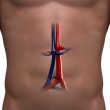This four-year retrospective analyzis has shown that contrast enhanced ultrasound based follow up protocol post endovascular aortic repair is safe and effective. Aneurysm related mortality, reintervention rate, sac retraction and endoleak detection resulted similar to that of CT based follow up protocols. In this study, doppler and enhanced contrast ultrasound were the main follow up<a href="https://solaci.org/en/2018/05/22/post-evar-contrast-enhanced-ultrasound-based-follow-up-reduces-ct-by-90-is-it-safe-though/" title="Read more" >...</a>
These were the 5 most read scientific articles of January
1) The 10 Commandments of ESC’s New STEMI Guidelines The authors have given an entertaining account of the most relevant points and differences between the new STEMI guidelines and the prior ones, from 2014. Read more 2) Burnout Syndrome among Cardiologists For the first time, the American College of Cardiology (ACC) has carried out a survey on this phenomenon,<a href="https://solaci.org/en/2018/02/01/these-were-the-5-most-read-scientific-articles-of-january/" title="Read more" >...</a>
The Importance of Knowing Which Conduits Will a Surgeon Use for Revascularization
Whether a second arterial conduit improves outcomes in patients undergoing myocardial revascularization surgery is and will remain unclear until the 10-year results of the ART (Arterial Revascularization Trial) are published. Consequently, arterial conduits other than the left internal thoracic artery are seldom used in daily practice. Using a database including 126 non-federal hospitals in California, researchers<a href="https://solaci.org/en/2018/01/30/the-importance-of-knowing-which-conduits-will-a-surgeon-use-for-revascularization/" title="Read more" >...</a>
Incidence of Cancer in Adult patients with Congenital Heart Disease
Adults with congenital heart disease are exposed to cumulative radiation doses, from multiple catheterization procedures. Seeing as these patients are exposed since early age, the chance of stochastic effect due to radiation exposure are relatively higher than that of the elderly population. It is clear the chance of incident cancer in adults with congenital heart disease is higher<a href="https://solaci.org/en/2018/01/29/incidence-of-cancer-in-adult-patients-with-congenital-heart-disease/" title="Read more" >...</a>
Dyspnea and Chronic Total Occlusion: A Symptom That We Can (Attempt to) Improve
Dyspnea is one of the most challenging symptoms as regards its assessment and treatment in patients with coronary disease, since it may stem from both cardiac and non-cardiac causes. Patients in whom dyspnea is the sole symptom of coronary disease are at a higher risk of not receiving adequate treatment, and their short- and long-term<a href="https://solaci.org/en/2018/01/26/dyspnea-and-chronic-total-occlusion-a-symptom-that-we-can-attempt-to-improve/" title="Read more" >...</a>
The 9 most read scientific articles of 2017 in interventional cardiology
1) New High Blood Pressure Guidelines The wait is finally over: the high blood pressure guidelines that have been in the works for the past 3 years saw the light of day at the American Heart Association (AHA) 2017 Scientific Sessions. Read more 2) Nearly half of interventional cardiologists may have pre-cataract lesions This statement is based on eye<a href="https://solaci.org/en/2018/01/23/the-9-most-read-scientific-articles-of-2017-in-interventional-cardiology/" title="Read more" >...</a>
Quality of Life Between Surgery and Angioplasty for the Treatment of Left Main Disease
In recent years, angioplasty with drug-eluting stents (DES) has emerged as an alternative to myocardial revascularization surgery in patients with left main coronary artery disease. Both European and American guidelines offer a Class IIa recommendation for left main coronary artery (LMCA) angioplasty in selected patients. The EXCEL (Evaluation of Xience Versus Coronary Artery Bypass Surgery for<a href="https://solaci.org/en/2018/01/11/quality-of-life-between-surgery-and-angioplasty-for-the-treatment-of-left-main-disease/" title="Read more" >...</a>
Radioprotection: 6 essential articles to keep you updated
1) On Radiation Protection: Editorial comment by Dr. Ariel Durán I am pleased to witness the increased amount of scientific papers in high impact journals addressing topics related to radiation protection or the harmful effects of radiation on our patients and primary or secondary operators. Similarly, it is my pleasure to see that SOLACI has<a href="https://solaci.org/en/2018/01/09/radioprotection-6-essential-articles-to-keep-you-updated/" title="Read more" >...</a>
Burnout Syndrome among Cardiologists
For the first time, the American College of Cardiology (ACC) has carried out a survey on this phenomenon, and more than 25% of Cardiologists have reported the characteristic symptoms of burnout. This syndrome is known, among other things, for chronic fatigue at work, low self-esteem and difficulty to focus, associated with stress and aggressiveness. These findings should be taken<a href="https://solaci.org/en/2018/01/05/burnout-syndrome-among-cardiologists/" title="Read more" >...</a>
6 articles on Total Chronic Occlusions that you can not stop reading
1) Radiation Exposure in Chronic Total Occlusions Even in the hands of experienced operators, rechanneling and angioplasty of a chronic total occlusion (CTO) results in patients and the whole cath lab team receiving high doses of radiation, according to this registry presented at the American Heart Association 2017 Scientific Sessions. Read more 2) Should We Begin to Use IVUS in CTO?<a href="https://solaci.org/en/2017/12/12/6-articles-on-total-chronic-occlusions-that-you-can-not-stop-reading/" title="Read more" >...</a>









